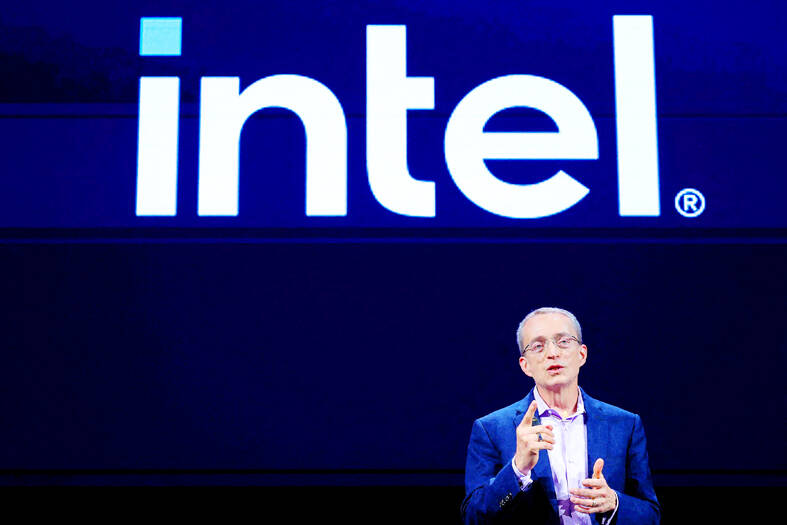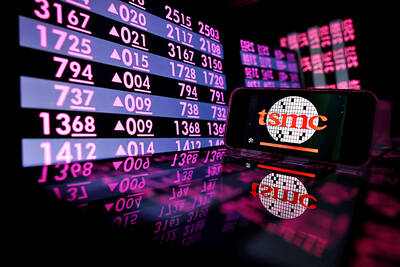Intel Corp is working with investment bankers to help navigate the most difficult period in its 56-year history, people familiar with the matter said.
The company is discussing various scenarios, including a split of its product design and manufacturing businesses, and which factory projects might potentially be scrapped, the people said, who asked not to be identified.
Morgan Stanley and Goldman Sachs Group Inc, Intel’s longtime bankers, have been providing advice on the possibilities, which could also include potential mergers and acquisitions, the people said. The discussions have only grown more urgent since Intel delivered a grim earnings report, which sent the shares plunging to their lowest level since 2013.

Photo: Ann Wang, Reuters
The various options are expected to be presented during a board meeting in September, but no major move is imminent and discussions are still in early stages, the people said.
A potential separation or sale of Intel’s foundry division, which is aimed at manufacturing chips for outside customers, would be an about-face for Intel CEO Pat Gelsinger. He has viewed the business as key to restoring Intel’s standing among chipmakers and had hoped it would eventually compete with the likes of Taiwan Semiconductor Manufacturing Co (台積電).
However, it is more likely that Intel takes a less dramatic step before it reaches that point, such as holding off on some of its expansion plans, the people said. The company has already done project financing deals with Brookfield Infrastructure Partners and Apollo Global Management.
Gelsinger is running out of time to pull off a much-needed turnaround. He has been attempting to expand the chipmaker’s factory network at the same time that sales are shrinking — a money-losing proposition. The company reported a net loss of US$1.61 billion last quarter, and analysts are predicting more red ink for the next year.
Gelsinger took the helm in 2021 and promised to restore the company’s technological edge. However, his comeback plan proved overly ambitious, and the company has had to scale back. Intel earlier this month said it plans to cut about 15,000 jobs and slash capital spending. The company even suspended its long-prized dividend.
“It’s been a difficult few weeks,” Gelsinger told investors at the Deutsche Bank Technology Conference on Thursday.
The company tried to lay out a “clear view” of its next steps during its earnings report, but the “market didn’t respond positively,” he said.
Intel director Tan Lip-bu (陳立武), who was brought in two years ago to help with the comeback effort, also abruptly stepped down from the board last week, citing scheduling commitments. His departure removed one of the few directors with industry knowledge and experience.
Intel shares have declined 60 percent this year, compared with a 20 percent gain for the Philadelphia Stock Exchange Semiconductor Index, a chip industry benchmark.
Gelsinger’s comeback plan hinged on recasting Intel into two groups: one that designs chips and another that manufactures them. The production arm would then be free to seek business from other companies. However, the biggest client of Intel’s factory network is still Intel. Until the foundry business has more outside customers, it is going to be challenged financially.
It reported operating losses of US$2.8 billion in its most recent quarter and is on course to have a worse year than projected.

Taiwan Semiconductor Manufacturing Co (TSMC, 台積電) yesterday said that its investment plan in Arizona is going according to schedule, following a local media report claiming that the company is planning to break ground on its third wafer fab in the US in June. In a statement, TSMC said it does not comment on market speculation, but that its investments in Arizona are proceeding well. TSMC is investing more than US$65 billion in Arizona to build three advanced wafer fabs. The first one has started production using the 4-nanometer (nm) process, while the second one would start mass production using the

‘SILVER LINING’: Although the news caused TSMC to fall on the local market, an analyst said that as tariffs are not set to go into effect until April, there is still time for negotiations US President Donald Trump on Tuesday said that he would likely impose tariffs on semiconductor, automobile and pharmaceutical imports of about 25 percent, with an announcement coming as soon as April 2 in a move that would represent a dramatic widening of the US leader’s trade war. “I probably will tell you that on April 2, but it’ll be in the neighborhood of 25 percent,” Trump told reporters at his Mar-a-Lago club when asked about his plan for auto tariffs. Asked about similar levies on pharmaceutical drugs and semiconductors, the president said that “it’ll be 25 percent and higher, and it’ll

When an apartment comes up for rent in Germany’s big cities, hundreds of prospective tenants often queue down the street to view it, but the acute shortage of affordable housing is getting scant attention ahead of today’s snap general election. “Housing is one of the main problems for people, but nobody talks about it, nobody takes it seriously,” said Andreas Ibel, president of Build Europe, an association representing housing developers. Migration and the sluggish economy top the list of voters’ concerns, but analysts say housing policy fails to break through as returns on investment take time to register, making the

CHIP BOOM: Revenue for the semiconductor industry is set to reach US$1 trillion by 2032, opening up opportunities for the chip pacakging and testing company, it said ASE Technology Holding Co (日月光投控), the world’s largest provider of outsourced semiconductor assembly and test (OSAT) services, yesterday launched a new advanced manufacturing facility in Penang, Malaysia, aiming to meet growing demand for emerging technologies such as generative artificial intelligence (AI) applications. The US$300 million facility is a critical step in expanding ASE’s global footprint, offering an alternative for customers from the US, Europe, Japan, South Korea and China to assemble and test chips outside of Taiwan amid efforts to diversify supply chains. The plant, the company’s fifth in Malaysia, is part of a strategic expansion plan that would more than triple